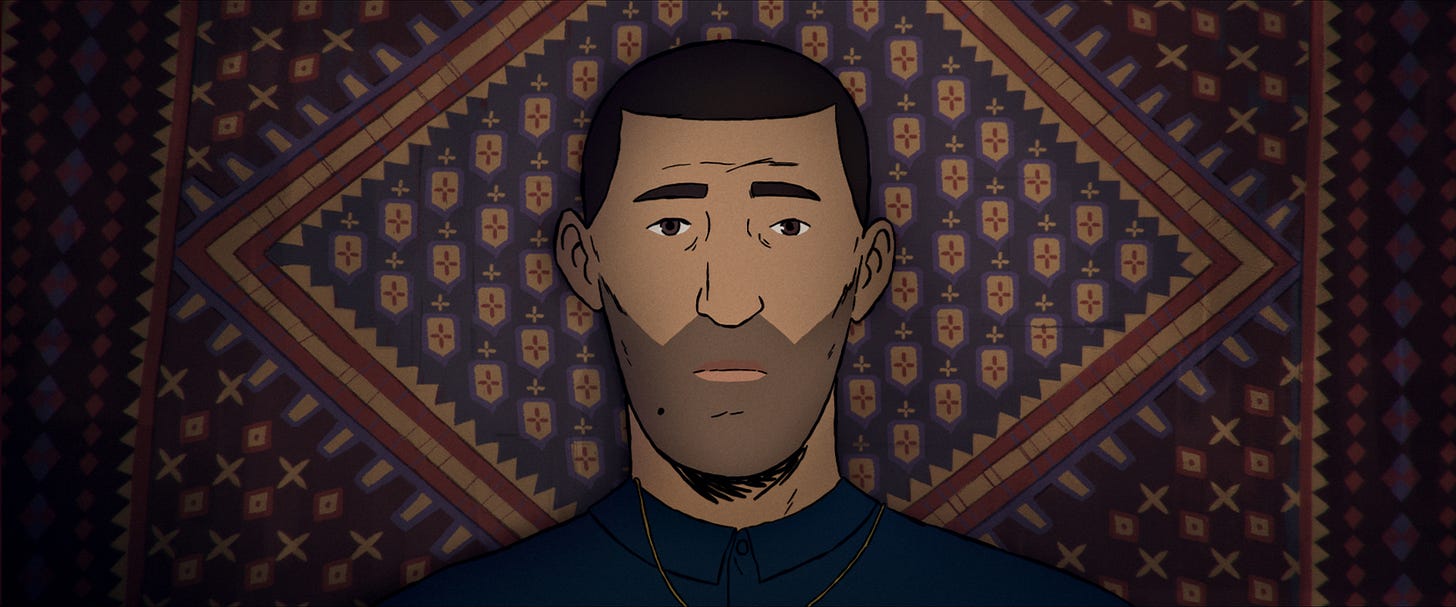Finding Refuge
Jonas Poher Rasmussen (director), "Flee" (2021)
I follow film so haphazardly that I first heard tell of Flee from my sister Georgia a month after the Oscar nominations went public on February 9, which I assume alerted her to its availability on Hulu, and why not? After all, Flee is up for not one Oscar but three: best animated film, best documentary film, best foreign film. Having caught just two of its competitors—Paolo Sorrentino’s The Hand of God in foreign and Questlove’s The Summer of Soul in documentary—I’m not about to handicap a winner much less argue for one. But I wouldn’t be scandalized if Flee won all three and will be chagrined if it doesn’t win animated or documentary, because that’s the formally audacious thing it is: an animated documentary. After all these years I still get a kick when “pop” usages like animation impinge on “serious” territory like documentary, although the technique has also been put to use in two other terrific films about the Muslim world: 2007’s Persepolis, based on Marjane Satrapi’s graphic novel about growing up during the Iranian revolution, and parts of 2015’s He Named Me Malala, about Pakistani Nobel Prize winner Malala Yousafzai’s struggle to educate Muslim girls and women starting with herself.
Flee’s director, 41-year-old Dane Jonas Poher Rasmussen, has two other documentaries on his resume, both of which would appear to excavate feelings as well as events the way Flee does: What He Did, about the murder of Danish novelist and gay liberationist Christian Kampmann, and Searching for Bill, in which a con man’s victim travels the U.S. in what’s described as an “impressionistic” search for fellow victims and the crook who screwed them. But it’s hard to imagine that either is as psychological as Flee, where the signature image is literally psychoanalytic: Amin, an Afghan refugee in his thirties with a neat gray beard rendered almost as a five o’clock shadow, lying on his back on a patterned carpet as Rasmussen prods him about his past—a past he says he’s never told the full truth about, so that he’s not even sure he remembers it properly, and also a past he is still compelled to misrepresent to an extent, obliging Rasmussen to caricature him so he’ll be harder to ID. Even now, a free man about to marry his Danish boyfriend who spends part of the film’s duration doing postdoctoral work at Princeton (if it’s really Princeton), he can’t risk being identified because it might compromise his own asylum or the safety of his family wherever they may be—perhaps even of his father, who was conscripted soon after the Soviets withdrew from Afghanistan in 1988-89 and, in this telling, soon disappeared.
For a brief while Amin spends something like a middle-class childhood in Kabul with his older brother and two older sisters, although soon we gather that an even older brother has already emigrated to Sweden. But Amin’s mother fears the worst as she has every reason to, and before long escapes with her four kids to Russia, the only nation anywhere that will grant them even a tourist visa. The plan is to move further west from there. But that requires money, and though her son in Sweden, whose cleaning job is more remunerative than anything available to an Afghan “tourist” in Russia, struggles heroically for most of the many years this film chronicles, all he can offer at first is perilous deals with the low end of the always criminal human trafficking business.
Nowhere is Rasmussen’s animation ploy more effective than in what is at once the film’s most memorable and its hardest-to-watch sequence: a three-part escape scenario that finds Amin and his family first trekking through a snow-covered forest in the dark with feebler refugees barely able to stand, then stuffed into the hold of a leaky boat they and their companions are compelled to bail themselves, and finally meeting up with a cruise ship that instead of rescuing them calls the Estonian cops. For me the linearity of the animated visuals intensified how painful all this was to watch—with no overacting to get my blood going and put my skepticism on alert, I was compelled to grasp and explore internally how frightful and inhumane the refugee experience is even as an abstraction.
Amin and his family’s economic struggles are ongoing, and their encounters with Russian cops so corrupt and brutal they make ours look like wusses are pretty alarming. Crucially, however, there are happier sequences. Trafficked to Copenhagen rather than Stockholm as he expects, Amin lies stalwartly and wins the support of the social worker Denmark provides him; he comes out to his older brother and sisters in Sweden and is met with a gratifyingly Scandinavian response; he learns to commit to his boyfriend the way they both need. Compelled to watch Flee twice because I had no thought of reviewing it first time, I felt not the slightest reluctance about seeing it again.

